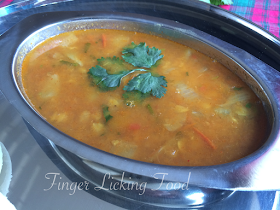This dish takes me back 15 years to when my grandmom(mom’s mom)
turned 60 and she took our entire family on a trip to see the Navagraha temples
in South India. It was a very well planned trip and we were almost at the end
of our trip of 10 days and we had a stop over at Tirunelveli. It was pretty
late and all of us a group of 15 including kids, famished, went into a
restaurant. We all decided to order Kothu Parota imagining Parotas and
delicious curry on the side not really knowing what Kothu meant!
What came
totally had us in surprise..Parota was torn to pieces almost minced, sautéed with onions and
tomatoes and different spices. All of us had ordered the same dish and we had a
good laugh before we ate. It was only then the waiter explained the dish to us.
Apparently this dish is popular in Tamil Nadu. This incident has us in splits
even today. But it was the inspiration to recreate my own version of the Kothu
Parota or Kothu Roti.
I’ve used leftover Chapatis (Rotis) instead of Parotas, its lighter
on the stomach and anytime there is leftover chapatis, this is the easiest and
tastiest way to finish them off. I’ve used eggs but this can be made without
eggs and it will be just as tasty.
Ingredients:
Serves:2
2 leftover 8-inch whole wheat Chapatis/Rotis
3 tbsp Oil
½ tsp Mustard seeds
½ tsp Fennel seeds
Few curry leaves
2-3 Green chillies, slit lengthwise (adjust to taste)
1 onion chopped
1 large tomato chopped
¼ tsp turmeric
2 eggs, beaten lightly
1-2 tsp Pav bhaji masala
1 tbsp Chopped cilantro
Heat oil in a pan. Add mustard and fennel seeds. Let it sizzle. Then
add curry leaves and slit chillies. Add chopped onions and sauté until done.
Add chopped tomatoes, and turmeric. Cook until tomatoes are soft. Add the
chopped chapatis.
Combine and then add the beaten eggs. Scramble on medium
heat. Season with salt and add pav bhaaji masala. Combine well and cook for a
few minutes. Garnish with chopped fresh cilantro and serve hot.
I never liked having leftover chapatis but
now I make extras so I can make delicious Kothu Roti the next day.







